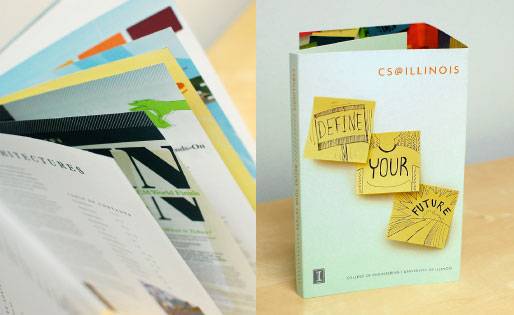 Talent is a funny thing. Either you’ve got it or you don’t. You can’t teach “talent” and that is something I struggle with every day as a graphic design professor at Parkland College. So what do you do when a student comes into your class who’s “got it”? You do the only thing that you can do — give them a little sunshine and some water. Then you leave them alone.
Talent is a funny thing. Either you’ve got it or you don’t. You can’t teach “talent” and that is something I struggle with every day as a graphic design professor at Parkland College. So what do you do when a student comes into your class who’s “got it”? You do the only thing that you can do — give them a little sunshine and some water. Then you leave them alone.
Kurt Bielema was one such student. Way back in 2000 or so, Kurt showed up in one of my classes. He didn’t know he “had it,” but it was obvious within a month that he stood above all the other students. So I left him alone, maybe encouraged him a little, maybe shared some resources with him. And he grew. Within a couple of years, he built a pretty damn good portfolio and got himself hired as a designer.
Kurt and I kept in touch. In the decade since, he got married (to one of his classmates, no less), became a father and is now running his own graphic design studio called Single Stereo. So when it came time to find someone to speak at Parkland’s new “Meet The Pros” lecture series, he was near the top of my list of people to ask. While preparing for his upcoming presentation, we recently caught up via email and Kurt answered a few nagging questions I’ve been meaning to ask him. Here’s what he had to say.
Smile Politely: When did you start to become interested in graphic design?
Kurt Bielema: I’ve always been interested in graphic design, but didn’t really figure out what to do with it until my late 20s. As a kid I was fascinated by the way things looked in print. Catalogs, packaging, and skateboard and bike magazines were early favorites. I loved the logos of the brands, and all the stickers you could order! I remember walking into a Gap store circa 1986 and thought it was the coolest thing; the neon-colored clothes presented so neat and orderly. When music became a big part of my life, album covers and rock posters were hugely influential. I recreated a few covers for art class in high school, and was on track to study design in college, but music hijacked my creative energies for a decade or so.
SP: But when you went to college, you didn’t study graphic design?
KB: Nope, I chose journalism, with an emphasis on advertising.
SP: So what did you do after college?
KB: After college I drifted a little, did some temp work, and then got a job at the News-Gazette. Although not working as a creative there, I did learn a lot about the biz. Working with other professionals, communicating, adhering to deadlines, caring about the end product and the level of work I produced — all skills that have helped me immensely with running my own business.

SP: What was your first graphic design job?
KB: It was at the News-Gazette. I worked there for years as an ad clerk and did some rudimentary page layout. Then I started taking graphic design classes at Parkland, and shortly thereafter was offered a promotion to design ads. I took it, but at the time knew it wasn’t what I wanted to do. I was hired by Taylor Studios right after I completed my last class at Parkland in 2002. My design skills really excelled there. I got to work on huge projects, fine-tune my presentation and conceptual skills, and learned a ton of stuff.
SP: How did you learn web design?
KB: I learned some basic concepts at Parkland, but the rest I learned by myself. As I go along, I feel it’s a real chore to stay on top of the technology of web design. Everything is much easier to do now, but it’s also easy to get left behind. I’m trying not to lose my edge because I love to create web sites.
SP: Why did you decide to start your own studio?
KB: I was working at Taylor Studios and doing freelance on the side, mostly web sites. I kept getting more and more freelance work on the side, and a few of my friends had just made the jump to self-employment (John Bonadies, Andy Warfel), so I decided to just go for it. After a short Powerpoint presentation to my wife, she gave me the green light. And six years later, I’m as busy as ever and working on some fantastic projects. But that’s not really why I started it…
SP: Powerpoint for your wife? Seriously?
KB: Well, it worked! For most of my 20s, I was determined to support myself though music. It was all I wanted to do, and I was obsessed. I knew I needed to do something else when the obsession turned into ennui. Fortunately, I had friends who were designers, and heard that some designers actually support themselves by freelancing. What a concept! Looking back, I realize it wasn’t necessary a career in music that I wanted, it was a career being creative. Having my own “studio of one,” as I call it, is really a misnomer. I have great collaborators, clients, peers, and friends whose influence flows through my work.
SP: Is there a relationship between music and design?
KB: Music is the soundtrack and design is the content, and both are critical ingredients to an interesting life. They’re both highly idiosyncratic and nuanced, and can communicate, confuse, inspire. For me, both are pursuits full of possibilities and discoveries. I don’t want to master either, but just to keep learning and creating.
SP: Which designers are you most inspired by?
KB: Any designer that embraces the concrete and abstract, the sublime and absurd. Levity is important. But so is a strict grid. If I had to name one, it would be Carlos Segura. I love the posters of Jason Munn. Our community has so many great designers to be inspired by, they’re the ones who really keep me pushing out the good work.
SP: Do you have a design philosophy?
KB: Not necessarily a “philosophy,” but things I like to keep in mind when designing include: start anywhere; levity, brevity, and repetition; the devil is in the details.
Kurt Bielema will be speaking at Parkland College on Wednesday, October 26 at 12 noon in room C118. Kurt’s presentation is part of “Meet the Pros,” a new lecture series sponsored by Graphic Design at Parkland College and 40 North 88 West. This free lecture series is open to the public and features designers, photographers, illustrators and other commercial artists in our local creative community.








